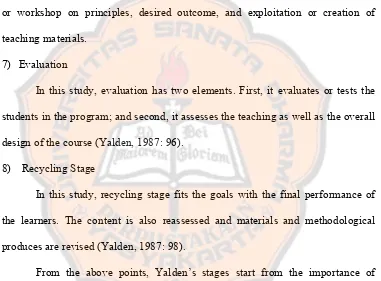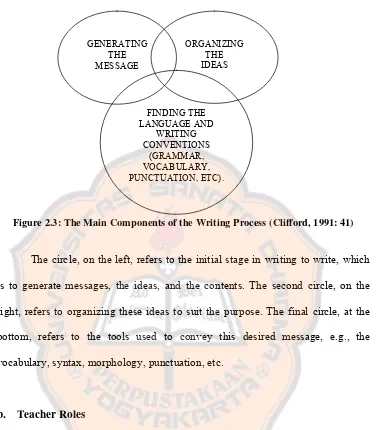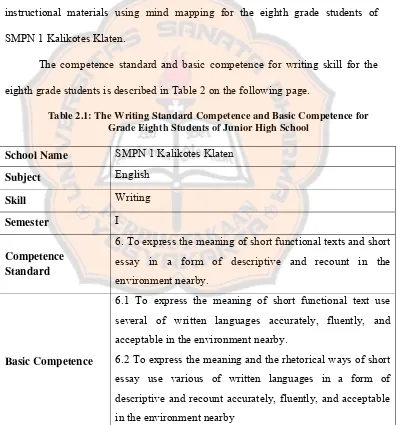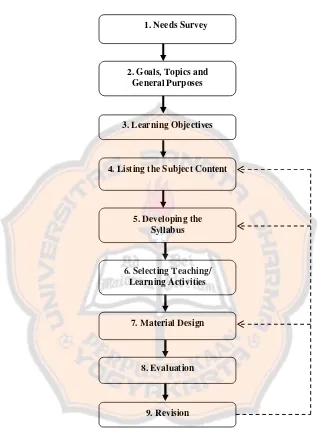Informasi Dokumen
- Penulis:
- Lia Ardiana Safitri
- Pengajar:
- Drs. J.B. Gunawan, M.A
- Christina Lhaksmita Anandari, S.Pd., M.Ed.
- Arina Isti’anah, S.Pd.
- Dwi Lestari Tarminaningsih, S.Pd.
- Fitri Puspitasari, S.Pd.
- Sumarlini, S.Pd
- Sekolah: Sanata Dharma University
- Mata Pelajaran: English Language Education
- Topik: Designing a Set of Writing Instructional Materials Using Mind Mapping for the Eighth Grade Students of SMPN 1 Kalikotes Klaten
- Tipe: Thesis
- Tahun: 2010
- Kota: Yogyakarta
Ringkasan Dokumen
I. Introduction
This section sets the stage for the research by establishing the context of writing instruction in English as a second language (ESL) for Indonesian eighth-graders. It highlights the challenges students face in writing, emphasizing the difficulty of generating, organizing, and translating ideas into coherent text, particularly when language proficiency is weak. The section also introduces mind mapping as a potential solution to these challenges, emphasizing its ability to enhance creativity and engage students actively in the writing process. The research problem is clearly defined, focusing on designing and presenting a set of writing instructional materials utilizing mind mapping for eighth-grade students at SMPN 1 Kalikotes Klaten. The research objectives, limitations, and benefits are outlined, setting clear boundaries and expectations for the study.
1.1 Research Background
This subsection delves into the significance of writing in ESL contexts, acknowledging its importance in communication and cultural participation. It cites research highlighting the difficulties many L2 learners experience with writing and the need for engaging instructional materials. The challenges faced by Indonesian students learning English are particularly emphasized, setting the context for the research's focus on improving writing skills among eighth-graders. The introduction of mind mapping as a potentially effective pedagogical tool is justified based on its capacity to foster both creativity and cognitive organization.
1.2 Problem Formulation
This subsection articulates the central research questions: How to design a set of writing instructional materials incorporating mind mapping for eighth-grade students at SMPN 1 Kalikotes Klaten; and what the final product of these instructional materials will look like. These questions provide a clear focus for the subsequent sections of the thesis, guiding the methodology and analysis.
1.3 Problem Limitation
This subsection clarifies the scope of the research, limiting the study to designing materials for first-semester eighth-graders at SMPN 1 Kalikotes Klaten. It explicitly states the selection of mind mapping topics and the alignment of the materials with the School Based Curriculum (SBC), highlighting the targeted approach of the study.
1.4 Research Objectives
The specific aims of the research are defined: to determine the design process of writing instructional materials using mind mapping for the targeted student population; and to present the finalized instructional materials themselves. These objectives directly address the research questions and provide measurable outcomes for the study.
1.5 Research Benefits
This subsection outlines the practical applications of the research findings for various stakeholders: English teachers at SMPN 1 Kalikotes Klaten (providing practical materials and enhancing creativity in teaching); eighth-grade students (improving writing skills and making the learning process more enjoyable); and future researchers (offering insights and a foundation for further studies in English language teaching, particularly writing instruction).
1.6 Definition of Terms
This subsection provides concise and unambiguous definitions of key terms such as instructional material design, writing (emphasizing both process and product), mind mapping, SMP, and SMPN 1 Kalikotes Klaten. This ensures clarity and consistency throughout the research.
II. Review of Related Literature
This chapter lays the theoretical groundwork for the study by examining relevant theories and models. It explores instructional design models (combining Kemp's and Yalden's models), the Communicative Language Teaching (CLT) approach, principles of writing instruction, the School Based Curriculum (SBC), and the application of mind mapping in education. The chapter systematically reviews each of these areas, extracting relevant theories and principles that inform the design and development of the writing instructional materials.
2.1 Theoretical Description
This subsection provides a detailed explanation of the theoretical underpinnings of the study. It delves into the chosen instructional design models, highlighting their strengths and explaining the rationale for their combined use. It meticulously explores the tenets of CLT, detailing its principles, learning theories, task types, roles of teachers and learners, and suitable teaching activities. A comprehensive overview of writing theories, principles for effective writing instruction, the benefits of writing, and the characteristics of good writing materials is provided. Finally, the relevance of the School Based Curriculum (SBC) and the pedagogical application of mind mapping are explained.
2.2 Theoretical Framework
This section synthesizes the reviewed literature to create a coherent theoretical framework that guides the research. It illustrates how the selected theories and models interrelate to provide a foundation for the design and development of the writing instructional materials using mind mapping. The framework highlights the key relationships between instructional design principles, communicative language teaching, the writing process, mind mapping techniques, and the relevant aspects of the SBC.
III. Methodology
This chapter details the research design and procedures. It outlines the research method used (Research and Educational Development – R&D), explaining the rationale for its selection. The research setting (SMPN 1 Kalikotes Klaten), participants (eighth-grade students and evaluators), and instruments (questionnaires and interviews) are clearly described. The data collection and analysis techniques are explained, providing a transparent account of how the research was conducted. The chapter also outlines the step-by-step research procedure, clarifying the stages involved in designing, evaluating, and revising the instructional materials.
3.1 Research Method
This subsection justifies the choice of the Research and Development (R&D) approach for this study, emphasizing its suitability for designing and evaluating instructional materials. It explains the specific R&D model used, highlighting how it aligns with the research objectives and provides a systematic framework for the study.
3.2 Setting
This subsection describes the context of the research, detailing the characteristics of SMPN 1 Kalikotes Klaten, including its curriculum (SBC) and the relevant demographics of the student population. This information is crucial for understanding the applicability and generalizability of the research findings.
3.3 Research Participants
This subsection identifies and describes the participants involved in the study, including the eighth-grade students who were the target users of the instructional materials and the evaluators (English lecturer, teachers, and instructor) who provided feedback on the materials' design and effectiveness. The rationale for selecting these participants is clearly articulated.
3.4 Research Instruments
This subsection outlines the data collection instruments used in the study, including questionnaires for students and evaluators, and interviews with teachers. The design and purpose of each instrument are detailed, providing a comprehensive understanding of the data collection process.
3.5 Data Gathering Technique
This subsection describes the procedures followed for collecting data, including the administration of questionnaires and the conduct of interviews. It provides details on the timeline of data collection and any precautions taken to ensure data quality and reliability.
3.6 Data Analysis Technique
This subsection explains how the collected data was analyzed, including the methods used for analyzing both quantitative and qualitative data. It describes the statistical techniques (if any) employed and explains how the qualitative data from interviews and open-ended questionnaire responses was interpreted.
3.7 Research Procedure
This subsection provides a step-by-step account of the research process, from the initial needs assessment to the final revision of the instructional materials. It explains the sequence of activities, including the design, development, evaluation, and revision phases of the R&D cycle.
IV. Research Findings and Discussion
This chapter presents the research findings, detailing the process of designing the writing instructional materials and discussing the evaluation results. It describes each step of the design process, including the needs survey, the specification of learning objectives, content selection, syllabus development, and the selection of teaching/learning activities. The chapter meticulously presents the evaluation data, providing a detailed analysis of both the syllabus and the materials themselves, considering strengths, weaknesses, and suggestions for improvement. The final version of the designed materials is presented, showcasing the results of the iterative design process.
4.1 The Elaboration Steps in Designing a Set of Writing Instructional Materials...
This section presents a detailed account of the step-by-step process followed in designing the writing instructional materials. Each step—from conducting the needs survey to revising the materials based on evaluation—is thoroughly described, providing insights into the design decisions made and their rationale. The data obtained at each stage is presented, illustrating how the findings informed the subsequent steps in the design process.
4.2 The Discussion on the Material Evaluation
This section presents a comprehensive analysis of the evaluation data collected from the evaluators. It details the feedback received on both the syllabus and the instructional materials, providing a detailed discussion of the strengths and weaknesses identified. The section explains how the evaluation data was used to inform the revisions made to the materials, illustrating the iterative nature of the design process.
4.3 Presentation of the Designed Materials
This section showcases the final version of the designed writing instructional materials. It provides a detailed description of the materials' content, structure, and pedagogical features, illustrating how the design incorporates the findings from the needs assessment and the evaluation process. The presentation should clearly demonstrate how the materials align with the research objectives and the theoretical framework presented earlier in the thesis.
V. Conclusions and Suggestions
This concluding chapter summarizes the key findings of the research, reiterating the main achievements of the study and their implications. It provides concluding statements that answer the research questions posed in Chapter 1. The chapter also offers suggestions for future research and practical applications of the findings, indicating areas for further investigation and potential improvements to the designed instructional materials.
5.1 Conclusions
This section summarizes the key findings of the research, directly answering the research questions posed earlier. It restates the main conclusions drawn from the data analysis, highlighting the effectiveness of the designed materials and the insights gained into the design process itself. The conclusions should be supported by evidence from the data presented in the previous chapters.
5.2 Suggestions
This section provides recommendations for both practical application and further research. It suggests ways in which the designed materials can be implemented effectively in the classroom setting and proposes areas for future research to expand upon the findings of this study. For instance, suggestions could include investigating the effectiveness of the materials in the classroom, exploring alternative techniques or media for teaching writing, and conducting longitudinal studies to track student progress over time.
Referensi Dokumen
- English in Focus: For Grade VIII Junior High School (SMP/MTs) ( Wardiman, Artono, et al. )
- English on Sky 2: for Junior High School Students Year VIII ( Mukarto, et al. )
- Contextual Teaching and Learning Bahasa Inggris Sekolah Menengah Pertama Kelas VIII ( Widiati, Utami, et al. )
- Albert Einstein – Biography ( Bellis, Mary )
- Understanding Types of Text: Handout to Learn English Text Types ( Ramadhani, Agus )









